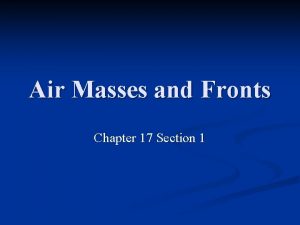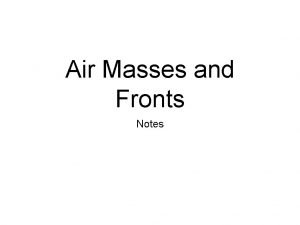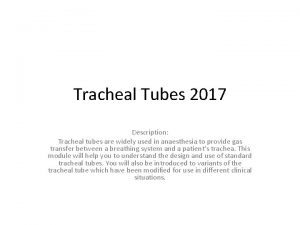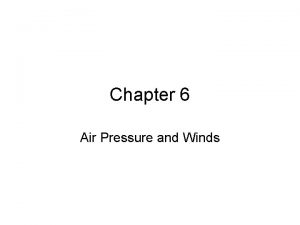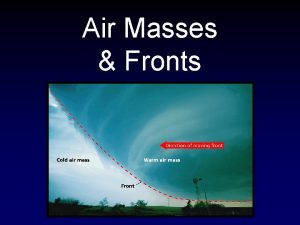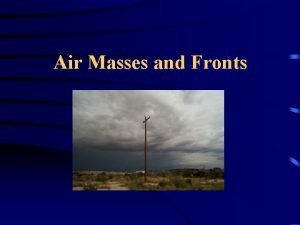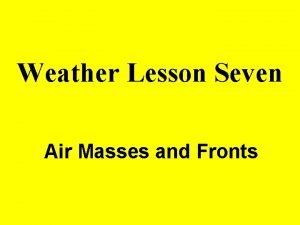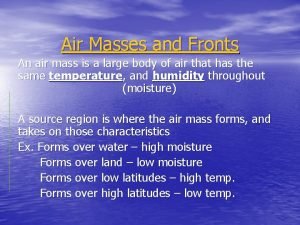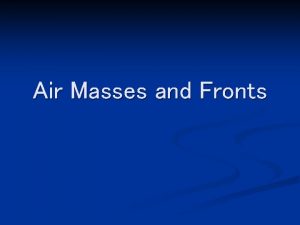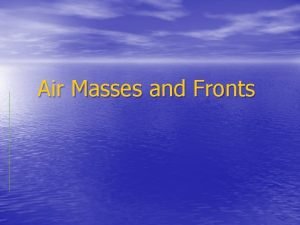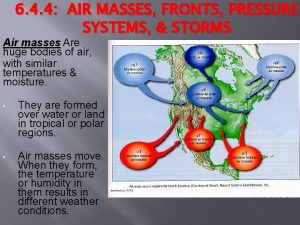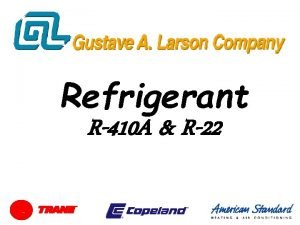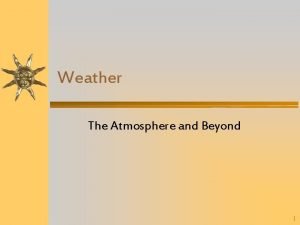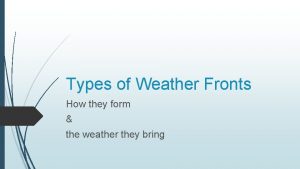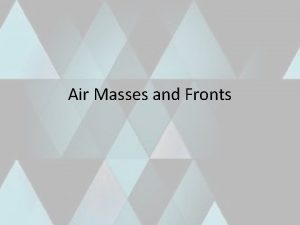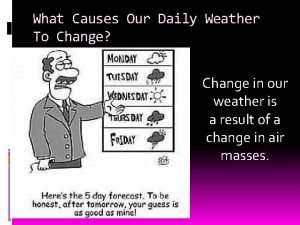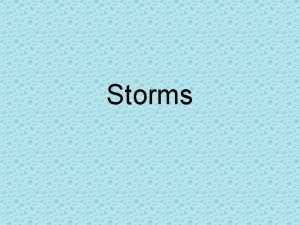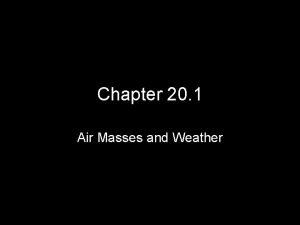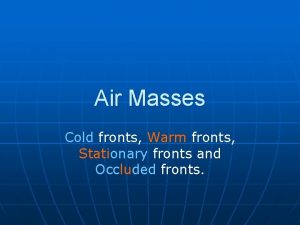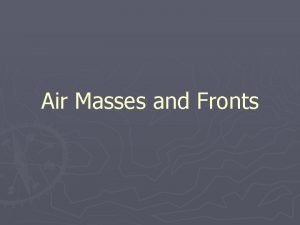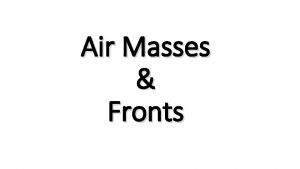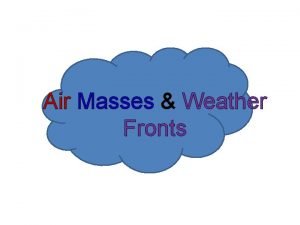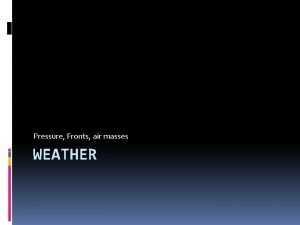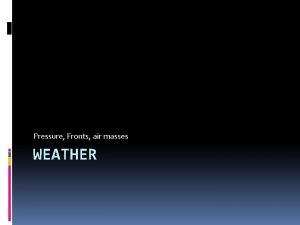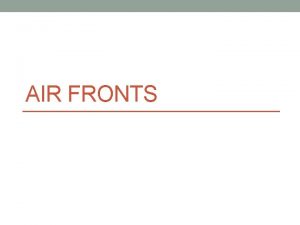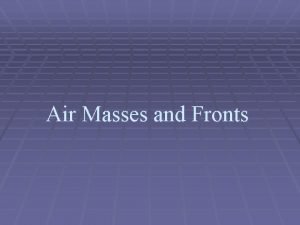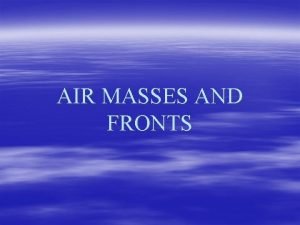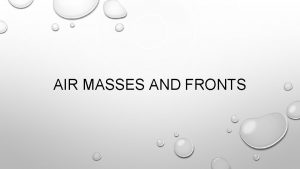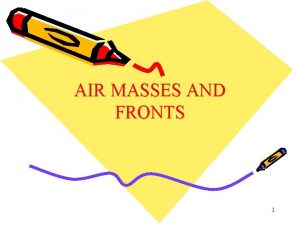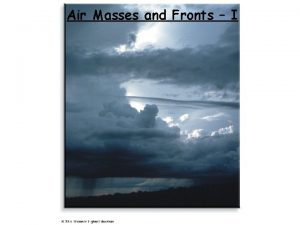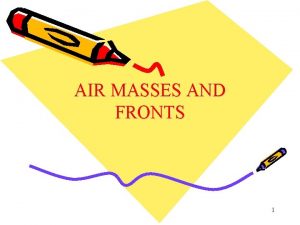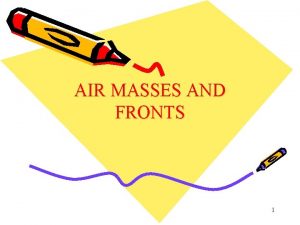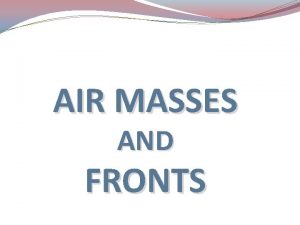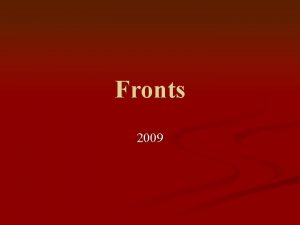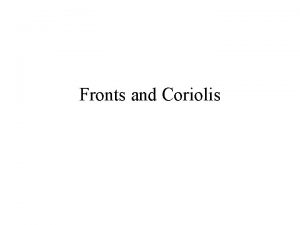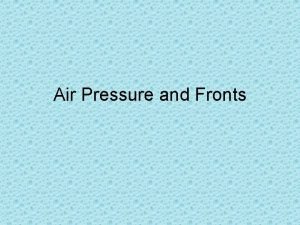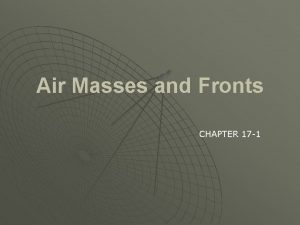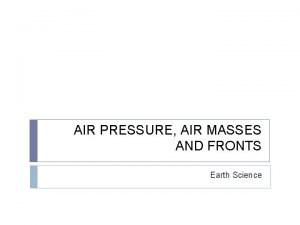Air Masses and Fronts High Pressure LOW PRESSURE






























- Slides: 30

Air Masses and Fronts

High Pressure

LOW PRESSURE

Low vs. High

Heating and Cooling of Air

Air circulation around a high pressure system Air circulation around a low pressure system

AIR MASSES § Similar horizontal properties § Temperature § Moisture content § Lapse rates § These characteristics are carried with it as air mass moves to other areas § Challenge of weather forecasting § To predict behavior of air masses § Where it will go and how it will change

Global Heating and Air Circulation § Unequal heating of the Earth causes general air circulation. § Global regions receive more direct radiation and therefore have higher temperatures. § The warmer equatorial air rises and moves toward the polar regions (cooling as it goes). The colder polar air sinks and is drawn toward the equator.


AIR MASS CLASSIFICATION SOURCE REGIONS § Maritime (m) – originates over oceans or large bodies of water § Continental (c) – originates over land § m or c indicate influence of surface on air mass characteristics (water and land) THERMAL TYPES § Tropical (T) – from low latitudes § Polar (P) – from mid-high latitudes § Arctic (A) – from high latitudes (> 65°N) § P and T suggest importance of latitude of source regions

What are the four types of air masses? § § Maritime Tropical Maritime Polar Continental Tropical Continental Polar

Maritime Tropical • Warm humid air masses from oceans near the tropics. • They form over the Gulf of Mexico and the Atlantic Ocean. • In the summer time maritime tropical usually bring hot humid weather. • In winter, a humid air mass can bring heavy rain or snow.

Maritime Polar § Cool humid air masses form over the icy cold North Pacific and North Atlantic oceans. § The air masses affect the west coast more than the east coast. § In the summer they often bring rain, fog, and cool temperatures to the west coast.

Continental Tropical § Hot dry air masses form only in the summer over dry areas of southwestern and northern Mexico. § Cover a smaller area than other air masses. § Bring hot, dry weather to the south.

Continental Polar § § Form over central and northern Canada and Alaska. Bring cool and cold air. In winter they bring clear, cool, and dry air to most of northern America. In the summer, storms may occur when continental air masses move south and meet maritime tropical that move north.

How do air masses move? § § The prevailing westerlies are the major wind belts in the United States. Prevailing westerlies push air masses from west to east.

Fronts § When air masses meet is a front, the collision often causes storms and weather changes. § A front may be 15 to 200 kilometers wide and extend as much as 10 kilometers up to the troposphere. § The kind of front that develops depends on the characteristics of the air masses and how they move.

There are four types of fronts. § § § Cold Fronts. Warm Fronts. Stationary Fronts. § Occluded Fronts.

Cold Fronts n n n n Cold air is dense and tends to sink. Warm air is less dense and tends to rise. When a moving cold air mass runs into a slowly moving warm air mass, the denser cold air slides under the warmer air. Warm air can hold more water vapor than cool air. If there is a lot of water vapor in the warm air heavy rain or snow may fall. Cold fronts move quickly so they can cause weather changes. After a cold front passes, cool, dry air moves in.

Warm Fronts § A moving warm air mass collides with a slowly moving cold air mass. § If the warm air is humid showers and light rain might. fall along the front where the warm and cold air meet. § If the warm air is dry scattered clouds may form. § After a warm front passes through an area the weather is likely to be warm and humid. § Winter warm fronts bring snow.

Stationary Fronts § Sometimes cold and warm air masses meet but neither one has enough force to move. § Where the warm and cold air meet, water vapor in the warm air turns into rain, snow, fog, or clouds.

Occluded Fronts § A warm air mass is caught between two cooler air masses. § As warm air cools and its water vapor condenses, the weather may turn cloudy, rainy, or snowy.

Cyclones and Anticyclones § As warm air at the center of a cyclone rises , the air pressure decreases. § Winds in s cyclone spin counterclockwise in the Northern Hemisphere. § As air rises in a cyclone the air cools forming clouds and precipitation. § Winds spiral outward from the center of an anticyclone, moving towards areas of low pressure. § Winds in an anticyclone spin clockwise in the Northern Hemisphere.

Cyclones § Hurricanes are very large cyclones that can cause widespread damage.

Anticyclones § Air flows clockwise around a highpressure system in the northern hemisphere. § Air tends to sink near high-pressure centers, which inhibits precipitation and cloud formation.

Vocabulary § Air mass- a huge body of air that has similar temperature, humidity, and pressure. § Tropical- or warm air masses form in the tropics and have low air pressure § Polar- or cold air masses from North of 50 o N latitude and South of 50 o S latitude. § Maritime- air masses that form over oceans § Continental- air masses form over land in the middle of continents and are dry. § Front- the area where the masses meet and do not mix. § Occluded- the warm air masses is cut off. § Cyclone- a swirling center of low air pressure. § Anticyclone- area of high pressure centers of dry air.

Section 1 Review 1. ) What two main characteristics are used to classify air masses? § Temperature § Humidity

Section 1 Review 2. ) What's a front? Name and describe the four fronts. § Front- the area where the masses meet but do not mix. § Cold Fronts- when a rapidly moving cold air mass runs into a slowly moving air mass, the denser cold air slides under the lighter warm air. § Warm Fronts- a moving warm air mass collides with a slowly moving cold air mass. § Stationary Fronts- sometimes cold and warm air masses meet but neither one has enough force to move. § Occluded Fronts- a warm air mass is caught between two cooler air masses.

Section 1 Review 3. ) What is a cyclone? What kind of weather does it bring? § Cyclone- a swirling center of low air pressure. § A cyclone usually brings precipitation and usually forms clouds.

Section 1 Review 4. ) Why do maritime polar air masses have more affect on the west coast than the east coast? § Maritime polar air masses has more affect on the west coast than the east coast because, of the cool humid air.
 A swirling center of low air pressure is called
A swirling center of low air pressure is called Area of low pressure where air masses meet and rise
Area of low pressure where air masses meet and rise Air masses form in the tropics and have low pressure
Air masses form in the tropics and have low pressure Air masses and fronts
Air masses and fronts Air masses notes
Air masses notes Air masses and fronts
Air masses and fronts North american air masses
North american air masses High pressure and low pressure
High pressure and low pressure Low atmospheric pressure
Low atmospheric pressure Pgf and coriolis force
Pgf and coriolis force Two cold air masses converge on a warm air mass
Two cold air masses converge on a warm air mass Maritime polar
Maritime polar Air masses & frontswhat is an air mass?
Air masses & frontswhat is an air mass? The boundary between two adjacent air masses is called
The boundary between two adjacent air masses is called Air masses & frontswhat is an air mass?
Air masses & frontswhat is an air mass? Air masses & frontswhat is an air mass?
Air masses & frontswhat is an air mass? Stationary front
Stationary front Mid low high
Mid low high Fronts and pressure systems
Fronts and pressure systems R22 pressure chart
R22 pressure chart Why does low air pressure usually indicate stormy weather
Why does low air pressure usually indicate stormy weather Types of fronts on a weather map
Types of fronts on a weather map Air fronts
Air fronts Characteristics of fronts
Characteristics of fronts A pattern of meteorological symbols that represent weather
A pattern of meteorological symbols that represent weather An instrument used to measure temperature
An instrument used to measure temperature Jet stream map
Jet stream map Warm front simple definition
Warm front simple definition Large rotating air mass
Large rotating air mass Importance of air masses
Importance of air masses Types of air masses
Types of air masses


